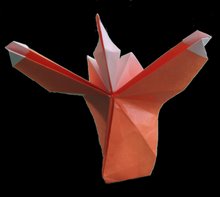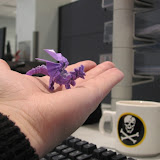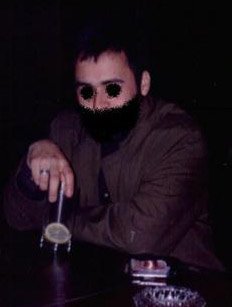
People like Nicaraguan Aldo Marcell, who in his solitude and conviction have developed incredible figures and an impressive spirit to understand representation and nature. His work as a botanic and his fascination for observing living things (humans included) allowed me to find in him a complex and balanced aesthetic in a slightly shy but reflexive person. Here you can see a small sample of his works, his amazing modular stars and a glimpse of the table he shared with chilean Beatriz Gonzalez and argentinean Meri Affranchino in the meeting's expo.


Also I met Diego Quevedo, from Colombia, CP solver, owner of an affective and honest personality, a great friend that I hope he can make to Chile on February for our Meeting. Here dictating his workshop on Cusco.

And then there were the guys from Origami Cusco, Antarki, Roy, Omar, Johnathan (and the remaining that my memory failed), a gang which I get really fitted. Hyperactives and great sense of humor haha. It's really amazing the youth of the whole group there, however their works are at the highest level. Made me laugh a lot since they expected me like some sort of celebrity or expert :lol: Also must recognize that our difference in age worried me at the beggining, but moment to moment with a good doze of jokes we felt part of the same experience and we all enjoyed it in the same level. Their enthusiasm and naturally to face every challenge pushed me to renew my votes and look forward a year specially hard for me and when, paradoxically my practice of origami have exploded and conquer an important place in my present.
here part of the gang...

Ten years ago I travelled to Cusco, then I was at University and prepared to live life in a full throttle way ans that was one of the best experiences in my life; I'm very happy that my return allowed me to find out that, some years older and sadder, life shows to me same as before, full of beauty, humor, emotions and people. A special greetings to Roberto Romero, a man who risk himself for what he believes and puts himselfin the frontline at the moment to materialize visions and projects. His organization of this Convention was impressive and fail proof, showing me an aspect of origami as important as forgotten: his social effect.

I've started on Origami as a personal activity, even selfish; sometimes we left on our own ego and carry our challenges to try to get excellence and perfection on our folds. This meeting just wired us to Earth; we gave workshop almost daily, from schools plenty of childrens to grown women on reinsertion. I've faced my reality, I have serious difficulties to teach begginers, people interested to start like my many years ago, I had to learn on the hall (thanks to Patricio Kunz) one or two effective figures to teach; but the experience of teaching and learning at the same time I had to get it myself, beautiful and hard.
Origami is an art, since it's representation, a language on which we represent, however is also therapy and game, we do not have to forget, helps a lot of people, like it helps us all, and it is magic also, to bring out a dove from a piece of paper, to make a penguin from nothing and make dream a human being with penguins and fantasies. That was the best I brought from Cusco, a real lesson I intend to use.
I've plublished the few pictures that I could rescue from my camera, also you can visit the web of Origami Cusco, there you can see the wonderful figures and moments we shared on Peru.












